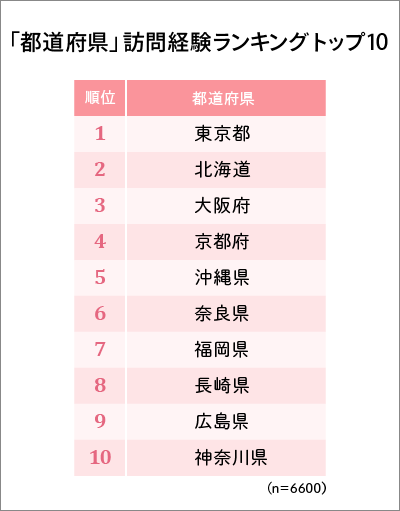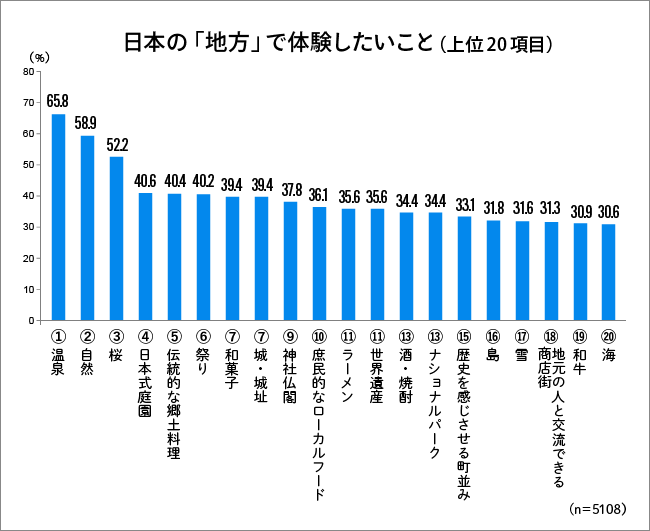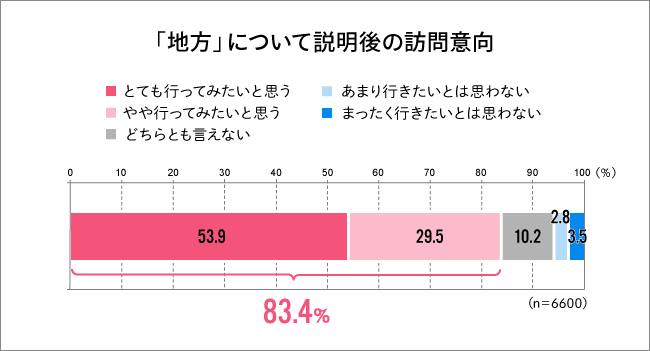News stories about "foreign tourists gathering in unexpected places in Japan" sometimes make headlines and spark conversation. I myself have spotted foreign tourists in inconvenient locations with limited transportation options and wondered, "How did they find out about this place, and how did they manage to get here?"
Japan has diverse "regions" with unique cultures, but how well are they known overseas, and what attracts visitors?
This series explores insights for future inbound business from the "Japan Brand Survey 2019," conducted in 20 countries and regions in December 2018. This time, we focus on "regional areas" and delve deeper.
Is it common knowledge that Japan has diverse and charming regions?
First, let's examine whether Japan's regions are recognized overseas. When asked about their image of Japan, 78.7% of respondents across all 20 countries and regions agreed that "Japan has regions with unique cultures."
The score was high at 83.5% in the Asia region, which is understandable. However, it was surprising to find that awareness was also relatively high in Europe (76.5%), North America (67.0%), and even Germany, which had the lowest score at 62.0%.
Furthermore, after providing the additional explanation, "Japan has diverse regions, each with distinctive tourist attractions, cuisine, and local specialties. (etc.)," and asking, "Would you like to visit Japan's regions?", a significant 83.4% expressed interest in going.
Over half specifically stated they "very much want to visit," indicating very high interest. This tendency was particularly strong in the ASEAN region, where over 70% expressed a "very strong desire to visit."
Furthermore, even among those without prior visitation to Japan, over 70% expressed a desire to visit regional areas. This raises expectations for the potential of regional Japan, prompting the question: "If awareness and understanding of Japan's regions deepens further, might inbound tourists increase even more?"
Visitors to Japan aren't just heading to Tokyo—regional areas are gaining traction too. Hokkaido is surging in popularity!
Let's look at which specific regions are popular and have high visit intentions. When prefectures were presented and respondents were asked about awareness, visit intentions, and visit experience, Tokyo topped all categories, unsurprisingly. Its awareness rate exceeds 60%.



Second place is Hokkaido. It ranks second only to Tokyo in all categories: awareness, visit intention, and visit experience. In the 2015 survey, Hokkaido ranked fifth in awareness and fourth in visit intention, showing its presence has surged dramatically over these four years.
Other prefectures well-known overseas include Osaka, Kyoto, followed by Hiroshima and Nagasaki, likely due to their historical significance. Two years ago, during group interviews with foreign residents in Japan, it was striking to hear participants from North America say, "In my home country, Hiroshima has become a place people want to visit at least once."
Furthermore, Fukushima Prefecture ranking as the eighth most famous prefecture in Japan reflects the high newsworthiness of the Great East Japan Earthquake overseas. Its visit intention score also ranks eighth, proportional to its recognition, with particularly high intentions in ASEAN countries like Indonesia and the Philippines. More people may extend their travels to Tohoku in the future.
Countries and regions in East Asia show high scores overall for awareness, visit intention, and visit experience. For visit experience, Tokyo ranks first, followed by Hokkaido, Osaka/Kyoto, Okinawa, and the Kyushu area (Fukuoka/Kumamoto).
As this trend gradually expands, it will be interesting to see which regions gain popularity next. After Kyushu, could it be Tohoku, Shikoku, or Chugoku?
The top experience people want in regional areas is "hot springs." Unique local cuisine is also drawing major attention!
When asked about "experiences they want to have in regional areas," "hot springs" ranked first. "Hot springs" also placed third in "things they want to do in Japan" and second in "things they are interested in regarding Japan," showing that foreigners, like Japanese people, find hot springs appealing.

Following hot springs were "nature," "cherry blossoms," "Japanese gardens," and "traditional local cuisine." The inclusion of "Japanese sweets" and "local street food" in the top 10 also shows many people want to experience regional food.
Ramen (11th place), which narrowly missed the top 10, was cited by over 50-60% of respondents in the Philippines, Taiwan, Hong Kong, South Korea, and Singapore as something they want to experience, highlighting its potential as a regional tourism resource.
Looking at the results by country/region, Turkey, included in the survey for the first time, had a top 10 list of "Nature," "Japanese Gardens," "Hot Springs," "Shrines and Temples," "Interaction with Samurai," "Cherry Blossoms," "Festivals," "Local Museums," "Traditional Crafts," and "Mountain Climbing/Trekking." This suggests a broad interest in regional areas, centered around history and culture.
In contrast, Hong Kong, with many repeat visitors, showed high interest in "hot springs," "nature," "cherry blossoms," "Wagyu beef," "autumn leaves," "ramen," "down-to-earth local food," "Japanese sweets," "snow," and "seafood." This distinctly highlights their strong focus on food and the four seasons.
Hong Kong has a high proportion of repeat visitors (80.7% are private repeat visitors), leading to more specialized travel purposes. In contrast, Turkey, with fewer visitors to Japan (75.7% have never visited), shows broader interests likely stemming from a desire to first understand Japan's national character and uniqueness.
This survey demonstrated exceptionally high interest in Japan's regional areas. Results confirm that interest among inbound tourists, particularly from East Asian countries and regions with high visitation rates, is gradually expanding to regional destinations.
To further leverage the potential of regional areas, it will be necessary to understand the needs of target countries and regions and match them effectively to attract visitors more efficiently.
Japan Brand Survey 2019 Overview
・Purpose: To understand overseas consumers' perceptions and actual behaviors regarding the overall "Japan Brand," including food, tourism, and Japanese products
・Target Areas: 20 countries and regions
China (Group A = Beijing, Shanghai, Guangzhou; Group B = Shenzhen, Tianjin, Chongqing, Suzhou, Wuhan, Chengdu, Hangzhou, Dalian, Xi'an, Qingdao), Hong Kong, Taiwan, South Korea, India, Singapore, Thailand, Indonesia, Malaysia, Vietnam, Philippines, Australia, USA (Northeast, Midwest, South, West), Canada, UK, France, Germany, Italy, Russia, Turkey
*This time, Brazil—which showed little change in past survey trends—was excluded, while Turkey, gaining attention for inbound tourism, was added.
・Survey Method: Online survey
・Respondent criteria: Men and women aged 20–59 *Middle-income level and above
*Definition of "middle-income class" (income criteria): Criteria set for each country based on national average income (OECD statistics, etc.) and social class classification (SEC)
・Sample size: China: 300 each for A and B groups, total 600; USA: 600; Other regions: 300 each, total 6,600
・Survey Period: December 2018
・Research organization: Video Research Ltd.









